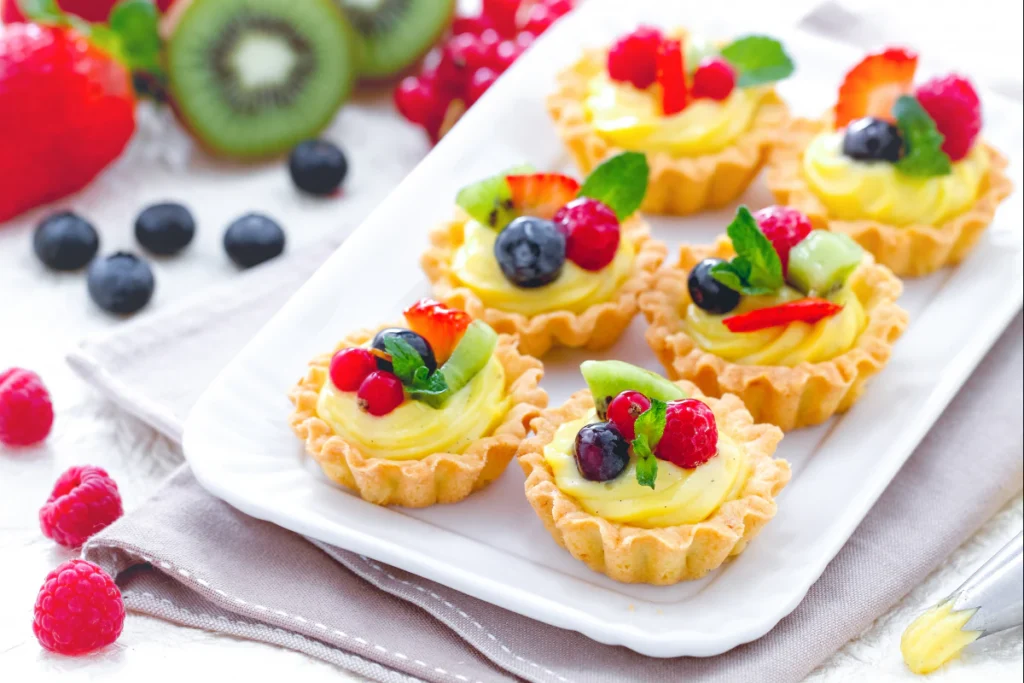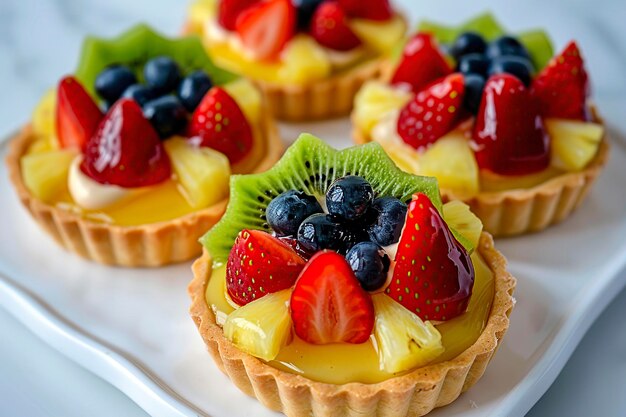INTROUDUCTION ABOUT FRUIT TART
A fruit tartlet is a delicate and colourful dessert that combines the rich flavours of a buttery tart shell with the creamy texture of pastry cream and the natural sweetness of fresh seasonal fruits. Often glazed for a glossy finish, these miniature treats are both visually appearing and delicious, making them a favourite at parties, afternoon teas, bakeries, and special events. Their versatility allows for endless variations using fruits like berries, kiwi, mango, and citrus, making them suitable for any season or occasion.

A fruit tartlet is a small, individual sized pastry that features a crisp and buttery crust, typically filled with a smooth custard or pastry cream, and topped with an artful arrangement of fresh fruits. These bite sized desserts are a miniature version of the classic fruit tart and are popular for their elegant presentation and refreshing taste.
FOR FRUIT TARTLET
- Crust: Traditionally made with a shortbread-like dough called pâté sucrée (sweet dough), similar to a shortbread cookie. Some recipes use pre-made phyllo cups or sugar cookie dough for a quicker approach.
- Filling: Vanilla pastry cream (crème pâtissière), a thick custard made with egg yolks, sugar, milk, and a thickening agent like cornstarch, is a common filling. Cream cheese filling, lemon curd, or even chocolate ganache are other options.
- Topping: Fresh, seasonal fruits such as berries, kiwi, peaches, plums, cherries, grapes, mango, and citrus fruits are popular choices. A melted apricot or apple jelly glaze can be brushed over the fruit for a glossy finish.
Fruit tartlets, although seemingly complex, are approachable to make from scratch, especially by preparing the components ahead of time. Many recipes also offer shortcuts, such as using pre-made tart shells or a simpler cream cheese filling, making them accessible to bakers of all skill levels.
FOR NICE FRUIT TARTLET
- Prevent soggy crust: Ensure the crust is fully baked and cooled before filling. Brushing the inside of the crust with melted chocolate or sprinkling a mixture of flour and sugar on the base can help create a barrier against moisture from the filling and fruit.
- Choose fresh, dry fruit: Use fresh, in-season fruit and dry it thoroughly after washing to prevent excess moisture from making the crust soggy.
- Don’t overmix the dough: Overmixing can lead to a tough crust.
- Chill the dough: Chilling the dough before baking helps prevent shrinking and maintains the shape of the tartlet shells.
- Watch the baking time: Tartlet shells can bake quickly, so keep an eye on them to prevent overbrowning.

Advantages
- Visually appealing: The colorful fruit toppings make tartlets a beautiful addition to any dessert spread.
- Convenient: Their small size makes them perfect for parties, brunches, or a quick individual treat, eliminating the need for plates and forks.
- Versatile: Recipes can be easily adapted to include different fruits and fillings based on seasonal availability and personal preferences.
- Make-ahead friendly: The crust and filling can be prepared in advance and stored separately for later assembly.
Where did fruit tartlets come from?
The earliest forms of tarts can be found in Egyptian and Roman cuisine, where they were mainly made with honey and fruits. However, it was the mediaeval European period that saw the development of the more familiar pastry crusts.
Ingredients for Fruit Tartlets
| Component | Ingredient | Quantity |
|---|---|---|
| Tart Crust | All-purpose flour | 1 1/4 cups (150g) |
| Unsalted butter (cold, cubed) | 1/2 cup (113g) | |
| Powdered sugar | 1/4 cup (30g) | |
| Egg yolk | 1 | |
| Cold water | 1-2 tbsp | |
| Pastry Cream | Whole milk | 2 cups (480ml) |
| Sugar | 1/2 cup (100g) | |
| Cornstarch | 1/4 cup (30g) | |
| Egg yolks | 4 | |
| Vanilla extract | 1 tsp | |
| Unsalted butter | 2 tbsp | |
| Topping | Fresh fruits (berries, kiwi, mango) | As needed |
| Apricot jam (optional, for glaze) | 2 tbsp (mixed with 1 tbsp water) |
How to Make Fruit Tartlets – Step-by-Step
Step 1: Make the Tart Crust
- In a bowl, mix flour and powdered sugar.
- Cut in the cold butter until the mixture resembles breadcrumbs.
- Add egg yolk and 1 tbsp cold water. Mix until the dough comes together.
- Wrap and chill for 30 minutes.
- Roll out the dough and cut to fit mini tart pans.
- Press into the pans, prick with a fork, and chill for 15 minutes.
- Preheat oven to 180°C (350°F) and bake crusts for 15–20 minutes or until golden. Cool completely.
Step 2: Prepare Pastry Cream
- Heat milk in a saucepan until just about to boil.
- In a separate bowl, whisk egg yolks, sugar, and cornstarch until pale.
- Slowly pour hot milk into the egg mixture, whisking constantly.
- Return to the pan and cook over medium heat until thickened.
- Remove from heat, stir in butter and vanilla.
- Cool, then chill for at least 1 hour.
Step 3: Assemble the Fruit Tartlets
- Spoon or pipe the chilled pastry cream into cooled tart shells.
- Top with sliced fresh fruits.
- (Optional) Brush with apricot glaze for shine.
- Serve immediately or refrigerate for up to 1 day.

Nutritional Role of Fruit Tartlet
| Component | Nutritional Role |
|---|---|
| Fruits (berries, kiwi, mango, etc.) | Rich in vitamins (A, C, E), minerals (potassium, magnesium), antioxidants, and dietary fiber. Boosts immunity and improves digestion. |
| Pastry crust (butter, flour, sugar) | Provides carbohydrates for energy. Butter contributes fat-soluble vitamins (A, D), but also saturated fats. |
| Custard or cream filling | Usually made from milk, eggs, sugar, and cornstarch. Supplies protein, calcium, and sometimes vitamin D. |
| Glaze (fruit jelly or syrup) | Adds sweetness and sheen. Mostly sugar-based, contributes simple carbohydrates (quick energy). |
Potential Benefits
- Antioxidants from fruits help fight oxidative stress.
- Dietary fiber promotes digestion and satiety.
- Calcium & protein from custard aid in bone and muscle health.
- Energy source due to carbs and sugars—great for a quick boost.
Points to Watch
- High in added sugars and fats, especially from the crust and glaze.
- Portion control is important if watching weight or blood sugar.
Summary
While fruit tartlets are a dessert, they can be nutrient-rich if made with whole fruits, low-fat dairy, and moderate sugar. They combine taste with a touch of nutrition—making them a better option than many processed sweets.
Conclusion:
The magic of fruit tartlets lies in their perfect balance of crisp pastry, smooth custard, and vibrant fresh fruit. These little delights are as pleasing to the eye as they are to the palate—light, refreshing, and full of natural sweetness. Whether served at a party or enjoyed with an afternoon tea, fruit tartlets add a touch of elegance and joy to any occasion. Try them once, and you’ll see just how magical they really are.


